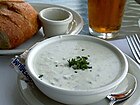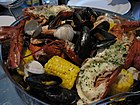Boston baked beans
 | |
| Course | Main |
|---|---|
| Region or state | New England |
| Associated cuisine | New England |
| Serving temperature | Hot |
| Main ingredients | Navy beans |
| Ingredients generally used | |
| Variations | Maine baked beans |


Boston baked beans are a variety of baked beans, sweetened with molasses, and flavored with salt pork or bacon.[1][2][3]
History[edit]
Native Americans had made corn bread and baked beans. The Pilgrims at Plymouth Colony learned these recipes in the early 1620s and likely added barley to the corn meal to invent New England brown bread. The triangular trade of slaves in the 18th century helped to make Boston an exporter of rum, which is produced by the distillation of fermented molasses. At that time, molasses was added to local baked bean recipes, creating a distinctive style of baked beans unique to New England.
In colonial New England, baked beans were traditionally cooked on Saturdays and left in brick ovens overnight. On Sundays, the beans were still hot, allowing people to indulge in a hot meal and still comply with Sabbath restrictions. Brown bread and baked beans along with frankfurters continue to be a popular Saturday night staple throughout the region.[1][2][3]
Regional varieties[edit]
The region has two main styles of baked beans: Boston baked beans and Maine baked beans. The difference between the two styles is that Boston beans are made with small white navy beans or pea beans with thin skin while Maine beans are made with native bean varieties with thicker skins. The varieties used in Maine are Marafax, soldier, and yellow-eye, with yellow-eye being the most popular variety.[4]
Both varieties are often made with salt pork or bacon. However, there is also a long tradition of vegetarian baked beans made with the same recipe as Boston baked beans or Maine baked beans but made without the addition of salt pork or bacon.[5][6]
Legacy[edit]
Boston is often referred to as “Beantown” in reference to the popular dish. From 1883 to 1906 the National League baseball team in Boston was known as the Boston Beaneaters. An annual tournament between the ice hockey teams of four Boston-area universities is named the Beanpot.
This dish is thought to have inspired the common Quebec dish Fèves au lard.[7]
See also[edit]
- List of regional dishes of the United States
- Original Boston Baked Beans, a candy by the Ferrara Candy Company
References[edit]
- ^ a b Albala, K. (2007). Beans: A History. Bloomsbury Publishing. p. 100. ISBN 978-0-85785-078-2.
- ^ a b Sletcher, M. (2004). New England. The Greenwood encyclopedia of American regional cultures. Greenwood Press. p. 237. ISBN 978-0-313-32753-7.
- ^ a b Ayto, J. (2012). The Diner's Dictionary: Word Origins of Food and Drink. Oxford Quick reference collection. OUP Oxford. p. 17. ISBN 978-0-19-964024-9.
- ^ Nash, Elias (2022-07-11). "The Subtle Difference Between Maine And Boston Baked Beans". TastingTable.com. Retrieved 2022-09-13.
- ^ Tucker, Aimee (2020-04-23). "Best Vegetarian Baked Beans Recipe | Vegetarian Baked Beans in a Crock Pot". New England Today. Retrieved 2022-09-16.
- ^ Schrumpf, Mildred Browne (1951). Maine's Own Baked Bean Recipes. Maine Department of Agriculture.
- ^ "Fèves au lard: la recette | Expérience Canadienne". www.houston-macdougal.com (in French). 1 April 2020. Retrieved 8 July 2023.


 French
French Deutsch
Deutsch

